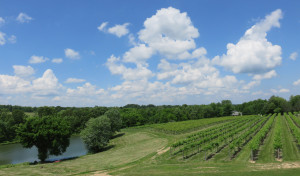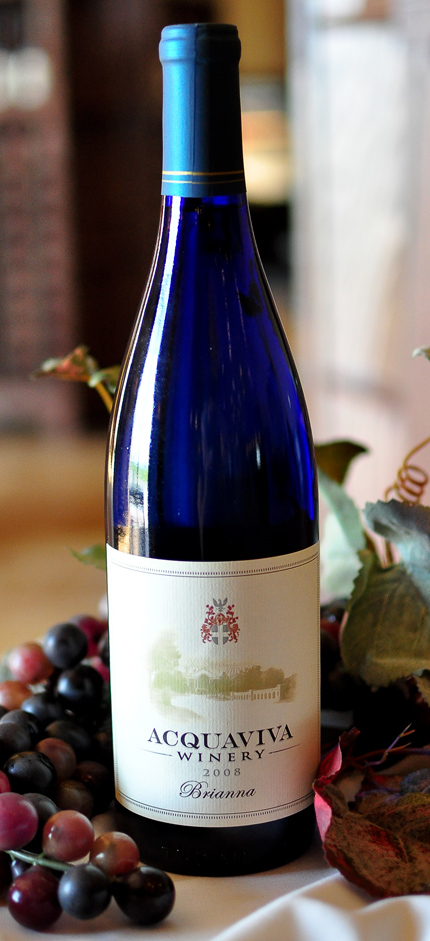New Guide to Illinois Wines and Wineries

The vineyard at Alto Vineyards and Winery in Alto Pass Illinois as seen from the winery’s new outdoor deck.
When visiting regional wineries, I like to taste wines made from local or estate grown grapes. As we’ve discussed in Midwest Wine Press, it’s the locally grown wines that are the main draw for most winery visitors.
That’s why I’m glad that there is now an Illinois winery guide that helps local wine enthusiasts find real Illinois wine. The attention devoted to Illinois grown wines in Clara Orban’s new book, Illinois Wines and Wineries is unprecedented in the Midwest. In addition to the histories of 89 different Illinois wineries, Orban details 74 wineries in Illinois that she has documented as growing their own grapes.
In most instances, Orban painstakingly lists both the specific varietal and acres under cultivation for each type of grape at each Illinois winery. (Some Illinois wineries would not respond to Orban’s inquiries, which is hard to understand.)
Besides being a great wine trip planner, Orban’s new book contains interesting insights into Illinois viticulture. For example, there are at least 33 different types of wine grapes being grown commercially in Illinois.
In comparison, California reportedly grows 60 types of wine grapes. Considering California’s wine industry is hundreds of times larger than the Land of Lincoln’s, the diversity of wine grapes is a testament to the skill of Illinois vignerons.
Examples of eclectic grapes used to make Illinois estate grown wines from Illinois Wines and Wineries Illinois include:
St. Vincent (Fergedaboudit Vineyard and Winery, Hanover)
Landot Noir (Fox Valley Winery, Oswego)
Valvin Muscat (Illinois River Winery, Utica)
St. Pepin (Rocky Waters Vineyard and Winery, Hanover)
Rubiana (Silver Moon Winery, Lanark)
Frontier and Ventura (Fox Creek Vineyards, Olney)
(Not all the grapes above are available as varietal wines. Some are blended with other grapes, which makes exploring Midwest wine even more interesting.)
Taking the prize for the most different kinds of varietals grown commercially in Illinois are the related August Hill/Illinois Sparkling wineries. These two sister wineries make highly regarded still and sparkling wines from 13 different types of estate grown Illinois grapes, according to Illinois Wine and Wineries.
Another surprise gleaned from Illinois Wines and Wineries is that more Illinois wineries grow University of Minnesota grapes (Marquette, Frontenac and La Crescent) than Labrusca grapes (Concord, Niagara and Catawba.) According to Orban, 27 Illinois wineries have at least one University of Minnesota varietal versus 20 wineries that grow one or more Labrusca varietals. This movement towards new hybrid grapes that make dry style wines demonstrates how tastes are changing among Illinois wine drinkers.
As far as Illinois is concerned, vinifera varietals can ripen only in the far southern part of the state. (Extreme Southern Illinois is a USDA 7a plant hardiness zone where sub zero weather is rare.) According to Orban’s research, the king of Illinois vinifera growers is Alto Vineyards in Alto Pass. Under the direction of Paul Renzaglia, Alto Vineyards grows four old world wine grapes: Albarino, Lemberger, Cab Sauvignon and Cab Franc.
Cab Franc grows well in Southern Illinois and makes distinctive, quality wines. Illinois Wines and Wineries will turn you on to six Southern Illinois wineries that make estate grown Cab Franc. Surprisingly, Orban has uncovered four Southern Illinois wineries that are growing Cab Franc’s famous progeny, Cabernet Sauvignon.
Orban is a French and Italian professor at DePaul University and also a Certified Sommelier. She is a careful and economical writer. Illinois Wines and Wineries contains none of the overextended prose that plagues wine writing (including Midwest Wine Press occasionally.)
Illinois Wines and Wineries is an essential companion on your next Illinois wine excursion and is availbable on amazon.com



